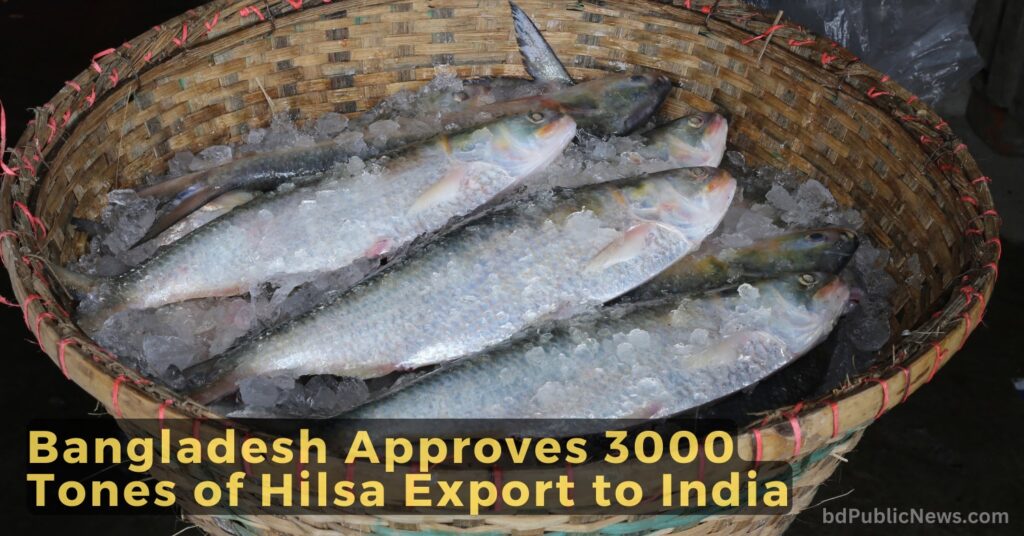Bangladesh Approves 3000 Tones of Hilsa Export to India for Durga Puja 2024
Bangladesh to Export 3,000 Tones of Hilsa to India for Durga Puja, Meeting Festive Demand in 2024
The government of Bangladesh has recently approved the conditional export of 3,000 tones of hilsa to India, timed strategically ahead of the forthcoming Durga Puja celebrations. This annual religious event holds immense cultural significance for millions of Hindus, particularly in the Indian state of West Bengal. For many, hilsa, a prized fish delicacy, plays a central role in festive feasts, making it an essential culinary addition during this season.
The demand for Bangladeshi hilsa in India, especially during Durga Puja, has always been high, given the fish’s iconic status in Bengali cuisine. In response to this seasonal demand, Bangladesh has intermittently relaxed its export restrictions, though such permissions have often been limited and controlled. The Ministry of Fisheries and Livestock, in coordination with the commerce ministry, typically oversees the export process. For this year’s approval, exporters have been directed to apply for the necessary permits at the commerce ministry’s office before September 24.
This decision comes after a previous halt in hilsa exports to India by the Bangladeshi government to prioritize local consumption. Bangladesh has long faced the challenge of balancing the lucrative export potential of hilsa with ensuring a stable domestic supply. Given that hilsa is a staple for many in Bangladesh, especially during festivals like Eid, the government’s commitment to protecting the local market has been clear. However, this annual relaxation of export restrictions during Durga Puja is seen as a goodwill gesture, solidifying diplomatic and cultural ties between Bangladesh and India.

Demand Surge in India
West Bengal, India, has always shown a heightened demand for hilsa during Durga Puja. The fish, known as “ilish” in Bengali, holds a place of prominence in traditional celebrations, with many families including it in their feasts as a symbol of prosperity and festivity. Despite Bangladesh’s export ban on hilsa to India, a special concession is typically made each year for this festival, demonstrating the cultural diplomacy at play between the two nations.
Kazi Belayet Hossain, president of the Bangladesh Frozen Foods Exporters Association (BFFEA), recently confirmed that his organization received official notification from the commerce ministry regarding this year’s conditional export permits. According to Hossain, while Bangladesh has maintained restrictions on hilsa exports for several years due to domestic supply concerns, the government regularly revisits the policy around Durga Puja. He noted that India has consistently requested the export of hilsa for this occasion, and this year’s approval is likely a result of diplomatic negotiations.
Although this decision is expected to satisfy the high demand for hilsa in West Bengal, concerns have been raised about its potential impact on local consumers in Bangladesh. Hossain, along with other stakeholders, expressed worry that domestic prices might spike as exporters begin to purchase large quantities of hilsa for shipment to India. This has been a recurring issue, with some consumers in Bangladesh facing rising prices whenever exports are approved. Exporters, however, argue that the revenue generated through international sales is vital for the country’s economy, especially considering the global reputation of Bangladeshi hilsa.
Positive Reception in India
In India, the Fish Importers Association has warmly welcomed Bangladesh’s decision. Syed Anwar Maqsood, the secretary of the association, described the news as a “positive development,” crediting continuous efforts by Indian stakeholders to maintain trade ties with Bangladesh. The association’s lobbying for hilsa exports each year is a testament to the enduring cultural connection hilsa has fostered between the two nations.
Maqsood also noted that the decision to approve 3,000 tonnes this year reflects the strong diplomatic relationship between India and Bangladesh. Despite the regular export ban, this annual concession is seen as an important diplomatic gesture, strengthening ties between the countries while addressing cultural and commercial demands in India. Indian consumers and traders are optimistic that this development will help stabilize prices during the busy festive season, as Bangladesh’s high-quality hilsa is preferred over locally sourced alternatives.
Export Figures and Market Impact
Export data from the Department of Fisheries reveals that during the fiscal year 2023-24, Bangladesh exported 664.86 tones of hilsa to India, generating $7.71 million in revenue. This marked a noticeable decrease from the previous fiscal year of 2022-23, when 1,376.42 tones were exported, bringing in $13.68 million. Despite the lower volume of exports, Bangladesh’s total domestic hilsa production has remained robust. In 2023 alone, the country produced 571,342 tones of hilsa, a significant figure that highlights the importance of this industry to both domestic and international markets.
Hilsa, often regarded as the “King of Fish” in the Bengali-speaking world, plays an essential role in the fisheries sector of Bangladesh. The country’s hilsa industry supports millions of livelihoods, from small-scale fishermen to large exporters. However, balancing the needs of the domestic market with the demand for exports has become increasingly challenging. As Bangladesh continues to experience growing demand from both local and international markets, the government must carefully manage its policies to ensure that neither side is disproportionately affected.
Future Implications
The conditional export of hilsa to India during Durga Puja is part of a long-standing tradition that demonstrates the cultural diplomacy between Bangladesh and India. However, the government’s approach to this export has evolved in recent years, as concerns about domestic supply and rising prices have taken center stage. The rising demand for hilsa, both in Bangladesh and abroad, means that careful planning and regulation will be essential in maintaining a balance between trade interests and local consumer needs.
Looking ahead, it will be crucial for the Bangladeshi government to continue refining its export policies to ensure that the country’s hilsa supply can meet the needs of both domestic consumers and international markets. Policymakers will need to consider innovative approaches, such as increasing sustainable fishing practices or enhancing domestic hilsa farming, to alleviate pressure on natural stocks. As Bangladesh navigates this delicate balancing act, its ability to manage hilsa exports while safeguarding local interests will remain a key challenge in the years to come.






